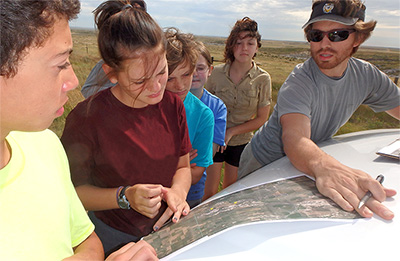Levering sees a lot to like in western Kansas

By Randy Gonzales
FHSU University Relations and Marketing
HAYS, Kan. -- Hands-on education can be fun, even in the summer. Just ask David Levering.
Levering has been putting together summer biology and paleontology camps the last two years as education director at Fort Hays State University's Sternberg Museum of Natural History.
The camps have been a big hit in just such a short time. For this summer's high school paleontology camp, Levering already has commitments from students from California and Michigan, and parents from Georgia, New York and Maine have inquired about the camp.
"It's neat to be able to bring kids in from that many different places, that many different walks of life and perspectives, and have them converge in our program here," Levering said.
Levering also knows he doesn't have to look far for something to pique his interest. This area is far from being a treeless plain with little value.
"I think the availability of outdoor natural history resources in western Kansas is helpful," Levering said. "There are world-class fossil localities within a short drive.
"The wealth of fossil resources is pretty spectacular," he added. "Beyond fossil material, there are excellent education natural history resources in wildlife."
Having a university nearby is an asset, too. Levering could find fossils when he worked summer camps back home in Oregon, but the eastern part of the state is isolated.
"The field station I worked at there were fossils within walking distance of the field site, but we didn't have the resource of a university onsite to work with as well," Levering said. "That's a big difference; there's an amazing fossil site near an academic institution like Fort Hays State University."
Just hop in the car and go. Field education opportunities are not far away. Levering likes to go fossil hunting at Castle Rock in Gove County, about an hour west of Hays.
"There are a lot of fish bones, a lot of clams," Levering said. "You can find sharks' teeth there once in a while.
"There's a lot of stuff here, and that availability makes these kinds of education programs easier," Levering said. "You don't have to drag people hours and hours away to get to anything worth looking at."
However, Levering's latest excursion was far from the Kansas prairie. He recently finished a spring break trip to Ecuador and the Galapagos Islands with seven Fort Hays State students. That's part of extending education to undergraduates. Before coming to FHSU, much of Levering's work had been with high school and younger students.
"It provides us a way to interact with the undergrads here in a new and very memorable way," Levering said.
Levering, who grew up in Salem, Ore., received his undergraduate degree in geology at the University of Oregon and his Master of Science in zoology at Oklahoma State University before arriving in Hays in the summer of 2013. Levering started out working summer camps in his native state.
Levering is putting his prior camp experience to good use at Fort Hays State. That was part of the draw in hiring him, said Dr. Reese Barrick, director of Sternberg Museum.
"David was a very enthusiastic young man with a background in a lot of outdoor education," Barrick said. "He also had a lot of experience working with camps."
Having initial financial support for the camps made a difference, Levering said.
"Being at a place where we were able to get that kind of support for the camps is absolutely wonderful as well as crucial to them getting off the ground," he said.
The Galapagos trip was an extension of the museum's outreach effort.
"What he's really brought to the museum that we haven't had a lot of in the past was an expansion of summer camps for older kids -- high school students, middle school students -- and working with college students," Barrick said. "The Galapagos trip was an opportunity to get more involved with the museum with students on campus."
Sami Montgomery, an FHSU freshman biology major from Topeka, said Levering would point out animals and plant life on the trip.
"It was really helpful," she said. "That really added the educational aspect to it."
This trip to the Galapagos -- where famed naturalist Charles Darwin studied animals and plant life -- sets up a planned trip next year to the same area for the general public. Levering already has his sights set on next year's FHSU Study Abroad spring break trip; he hopes to lead students on a trek to the Amazon.
That would continue the theme of conservation, one of the areas delved into on the Galapagos trip. The need for conservation of our resources was exhibited during the trip when a pelican was spotted trying to swallow a plastic bag.
"That was a really good on-site demonstration of negative human impacts on nature and wildlife," Levering said. "If we don't consciously work on wildlife and ecosystem conservation and try to protect these things, they're going to go away. They're not going to last longer if the people who care about them do nothing."
Levering credits Barrick for the opportunity to offer summer camps, the trip to the Galapagos Islands and perhaps a trip to the Amazon.
"In working with Dr. Barrick at the museum, he's very interested in trying new things, which makes something like the summer science camps and the field programs a lot easier," Levering said. "Being in that kind of environment has been crucial in being able to have these really cool, becoming-more-successful programs."
Information on the Sternberg Museum's science camp programs can be found at http://sternberg.fhsu.edu/active-learning/camps/
Cutline: David Levering (far right) shows high school paleontology campers how to orient with a map and a compass -- an under-appreciated skill in the age of cell phone GPS navigation.